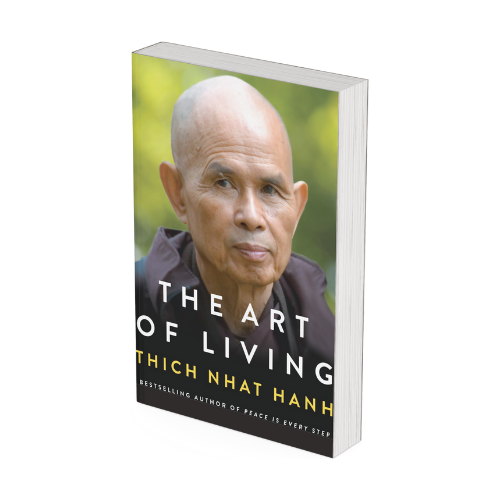The Art of Living
by Thich Nhat Hanh
Thich Nhat Hanh (1926–2022) was a Vietnamese Buddhist monk, teacher, and peace activist known for bringing mindfulness to the modern world. A Zen master and poet, he wrote over 100 books on mindfulness, meditation, and compassion. Exiled from Vietnam during the war, he dedicated his life to promoting peace, interfaith dialogue, and practical spirituality. His teachings blend traditional Buddhist wisdom with simple, actionable insights for daily life. He helped countless people cultivate inner peace, self-awareness, and mindful living through his global retreats and the Plum Village community. His philosophy is rooted in love, presence, and interconnectedness.
Summary of “The Art of Living”
In The Art of Living, Thich Nhat Hanh explores how to live a significant life by practising mindfulness and embracing the present moment. He teaches that true happiness doesn’t come from chasing external achievements but from being fully present and aware of the interconnected nature of all things.
The Seven Realities of Awakeningerve as guiding principles for mindful living.
Impermanence – Everything is constantly changing, and accepting this brings freedom.
Non-Self – We are not separate individuals but deeply interconnected with everything.
Interbeing – Nothing exists independently; we are all part of a greater whole.
Mindfulness – True happiness comes from fully experiencing the present.
Concentration – A focused mind leads to insight and peace.
Insight – Seeing reality frees us from suffering.
Nirvana – True peace comes from letting go of attachment and fear.
Thich Nhat Hanh explains how applying these principles can transform our daily lives. Whether it’s drinking tea, walking, or breathing, he emphasizes that every moment is an opportunity to cultivate joy and awareness. He also addresses death, showing how understanding impermanence helps us fully embrace life.
At its core, The Art of Living is a practical guide to spiritual awakening, helping readers find peace, purpose, and deeper connection in their everyday lives.
My Thoughts on “The Art of Living”
This book is a reminder of how simple, yet profound, life can be when we learn to slow down and pay attention. Thich Nhat Hanh has a way of distilling deep wisdom into clear, practical teachings that anyone can apply. His writing is gentle but powerful, encouraging us to stop rushing through life and live.
One of the biggest takeaways for me is impermanence. We often resist change, fearing loss and uncertainty, but this book reframes it as a natural and beautiful part of life. When we truly understand that everything is temporary, we can stop clinging to what we can’t control and instead learn to appreciate each moment fully.
I also love his concept of interbeing—the idea that nothing exists in isolation. We are not separate from nature, others, or the past and future. This perspective is a game-changer, especially in relationships. It helps us see that our happiness is tied to the happiness of those around us and that kindness, mindfulness, and compassion are not just personal choices but responsibilities.
Another powerful insight is how mindfulness doesn’t have to be complicated.
You don’t need to meditate for hours or escape to a monastery. Every simple action—breathing, walking, eating—can be a mindfulness practice if you are fully present. Thich Nhat Hanh teaches that enlightenment isn’t about achieving some mystical state; it’s about fully experiencing life as it is.
That being said, living this way takes practice. It’s easy to get caught up in stress, distractions, and overthinking. But every time I apply these teachings—whether by taking a mindful breath or simply observing my thoughts without judgment—I feel more grounded.
Overall, The Art of Living is a book I think everyone should read at least once. It doesn’t just offer ideas; it provides a roadmap for living with more peace, clarity, and love. It’s the kind of wisdom that, if applied, can completely transform how we experience life.
I encourage clients and colleagues to incorporate the teachings from “The Art of Living.”
Here are key lessons I believe therapists, coaches, and anyone seeking a more peaceful life should take from this book:
Practice mindfulness in everyday activities.
You don’t need extra time—just bring awareness to what you’re already doing.
Accept impermanence. Instead of fearing change, embrace it as a natural part of life.
Recognize our deep interconnectedness. Your actions, thoughts, and emotions affect others more than you realize.
Let go of attachment. Clinging to people, outcomes, or material things leads to suffering. Learn to appreciate without needing to own or control.
Breathe consciously. A single mindful breath can bring instant calm and clarity.
Find joy in simple moments. Happiness isn’t in the future—it’s in fully experiencing the present.
Observe your thoughts without getting lost in them. You are not your thoughts; you can watch them and choose how to respond.
Approach death with wisdom, not fear. Understanding impermanence allows us to live more fully and love more deeply.
Live with intention. Instead of going through life on autopilot, choose how you want to show up each day.
By applying these principles, we can cultivate a way of living that is peaceful, purposeful, and deeply fulfilling.
In Summary
The Art of Living by Thich Nhat Hanh is a beautifully written guide on how to live with more mindfulness, peace, and purpose. Through simple yet profound insights, he teaches that true happiness comes from being fully present and embracing life’s impermanence. This book isn’t just about spirituality—it’s about learning to experience each moment with clarity and joy. If you’re looking for a book to help you slow down, find peace, and truly live, this is it.
The Art of Living
by Thich Nhat Hanh
Thich Nhat Hanh (1926–2022) was a Vietnamese Buddhist monk, teacher, and peace activist known for bringing mindfulness to the modern world. A Zen master and poet, he wrote over 100 books on mindfulness, meditation, and compassion. Exiled from Vietnam during the war, he dedicated his life to promoting peace, interfaith dialogue, and practical spirituality. His teachings blend traditional Buddhist wisdom with simple, actionable insights for daily life. He helped countless people cultivate inner peace, self-awareness, and mindful living through his global retreats and the Plum Village community. His philosophy is rooted in love, presence, and interconnectedness.
Summary of “The Art of Living”
In The Art of Living, Thich Nhat Hanh explores how to live a significant life by practising mindfulness and embracing the present moment. He teaches that true happiness doesn’t come from chasing external achievements but from being fully present and aware of the interconnected nature of all things.
The Seven Realities of Awakeningerve as guiding principles for mindful living.
Impermanence – Everything is constantly changing, and accepting this brings freedom.
Non-Self – We are not separate individuals but deeply interconnected with everything.
Interbeing – Nothing exists independently; we are all part of a greater whole.
Mindfulness – True happiness comes from fully experiencing the present.
Concentration – A focused mind leads to insight and peace.
Insight – Seeing reality frees us from suffering.
Nirvana – True peace comes from letting go of attachment and fear.
Thich Nhat Hanh explains how applying these principles can transform our daily lives. Whether it’s drinking tea, walking, or breathing, he emphasizes that every moment is an opportunity to cultivate joy and awareness. He also addresses death, showing how understanding impermanence helps us fully embrace life.
At its core, The Art of Living is a practical guide to spiritual awakening, helping readers find peace, purpose, and deeper connection in their everyday lives.
My Thoughts on “The Art of Living”
This book is a reminder of how simple, yet profound, life can be when we learn to slow down and pay attention. Thich Nhat Hanh has a way of distilling deep wisdom into clear, practical teachings that anyone can apply. His writing is gentle but powerful, encouraging us to stop rushing through life and live.
One of the biggest takeaways for me is impermanence. We often resist change, fearing loss and uncertainty, but this book reframes it as a natural and beautiful part of life. When we truly understand that everything is temporary, we can stop clinging to what we can’t control and instead learn to appreciate each moment fully.
I also love his concept of interbeing—the idea that nothing exists in isolation. We are not separate from nature, others, or the past and future. This perspective is a game-changer, especially in relationships. It helps us see that our happiness is tied to the happiness of those around us and that kindness, mindfulness, and compassion are not just personal choices but responsibilities.
Another powerful insight is how mindfulness doesn’t have to be complicated.
You don’t need to meditate for hours or escape to a monastery. Every simple action—breathing, walking, eating—can be a mindfulness practice if you are fully present. Thich Nhat Hanh teaches that enlightenment isn’t about achieving some mystical state; it’s about fully experiencing life as it is.
That being said, living this way takes practice. It’s easy to get caught up in stress, distractions, and overthinking. But every time I apply these teachings—whether by taking a mindful breath or simply observing my thoughts without judgment—I feel more grounded.
Overall, The Art of Living is a book I think everyone should read at least once. It doesn’t just offer ideas; it provides a roadmap for living with more peace, clarity, and love. It’s the kind of wisdom that, if applied, can completely transform how we experience life.
I encourage clients and colleagues to incorporate the teachings from “The Art of Living.”
Here are key lessons I believe therapists, coaches, and anyone seeking a more peaceful life should take from this book:
Practice mindfulness in everyday activities.
You don’t need extra time—just bring awareness to what you’re already doing.
Accept impermanence. Instead of fearing change, embrace it as a natural part of life.
Recognize our deep interconnectedness. Your actions, thoughts, and emotions affect others more than you realize.
Let go of attachment. Clinging to people, outcomes, or material things leads to suffering. Learn to appreciate without needing to own or control.
Breathe consciously. A single mindful breath can bring instant calm and clarity.
Find joy in simple moments. Happiness isn’t in the future—it’s in fully experiencing the present.
Observe your thoughts without getting lost in them. You are not your thoughts; you can watch them and choose how to respond.
Approach death with wisdom, not fear. Understanding impermanence allows us to live more fully and love more deeply.
Live with intention. Instead of going through life on autopilot, choose how you want to show up each day.
By applying these principles, we can cultivate a way of living that is peaceful, purposeful, and deeply fulfilling.
In Summary
The Art of Living by Thich Nhat Hanh is a beautifully written guide on how to live with more mindfulness, peace, and purpose. Through simple yet profound insights, he teaches that true happiness comes from being fully present and embracing life’s impermanence. This book isn’t just about spirituality—it’s about learning to experience each moment with clarity and joy. If you’re looking for a book to help you slow down, find peace, and truly live, this is it.
“The greatest glory in living lies not in never falling, but in rising every time we fall.”
Recent Thoughts
When Love Turns to Hate: Why Justice Must Stay in the Courtroom and Not Online
As a therapist working closely with couples and individuals in high-conflict relationships, I have seen the full emotional arc of love, from intimacy
Stress at the Top
Why Leadership in Malta is More Isolated Than You Think We often picture business leaders as confident, driven, and in control. They make




